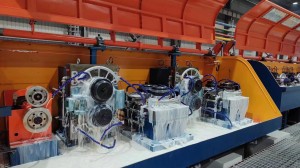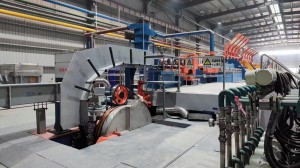Continuous casting and rolling production lines are widely used in the manufacturing industry to produce high-quality metal rod products in large quantities. One such production line is the copper/aluminum/aluminum alloy rod continuous casting and rolling production line. In this article, we will discuss the process, equipment, and advantages of this production line.

Process:
The copper/aluminum/aluminum alloy rod continuous casting and rolling production line comprises two stages: continuous casting and rolling. The continuous casting stage involves melting the raw material and casting it into a continuous billet. The billet is then transferred to the rolling stage, where it is rolled into a rod of the required diameter.
Equipment:
The production line consists of several pieces of equipment, including a furnace, continuous casting machine, roller table, rolling mill, cooling bed, and coiler. The melting furnace is used to melt the raw material (copper, aluminum, or aluminum alloy) and pour it into the holding furnace. The holding furnace keeps the molten metal at a constant temperature before it is fed into the continuous casting machine.
The continuous casting machine cast the molten metal into a billet of the required size and shape. The billet is then guided by a roller table to the rolling mill. The rolling mill consists of a series of rollers that gradually reduce the billet's diameter and shape it into a rod of the required diameter. The coiler is used to wind the rod into coils.

Advantages:
The copper/aluminum/aluminum alloy rod continuous casting and rolling production line has several advantages over traditional production methods. One of the most significant advantages is the ability to produce high-quality metal products in large quantities. The continuous casting and rolling process ensures consistent quality and eliminates the need for multiple processing steps, which reduces production time and cost.
Another advantage of this production line is its energy efficiency. The use of continuous casting and rolling eliminates the need for reheating the metal, which reduces energy consumption and greenhouse gas emissions. Moreover, the production line's automation ensures that the process is more efficient and requires less manual labor.
In conclusion, the copper/aluminum/aluminum alloy rod continuous casting and rolling production line is an efficient and cost-effective method for producing high-quality metal products. Its use of continuous casting and rolling technology ensures consistent quality, reduces energy consumption, and eliminates the need for multiple processing steps, making it an ideal production method for the manufacturing industry.
